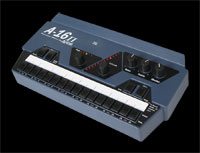Continuing our series on the hot topic of monitoring, the following advice comes from Barry Pike, ProAudio.com Account Manager. A dedicated musician for most of his life, Barry plays electric guitar in three services at his church every weekend. If you read our post from February by Kevin Lorensen, you’ll see some common themes developing: add only what you need to the mix, and keep the volume down.
We have used the Aviom Pro16 digital snake and personal monitoring system for the last 8 years or so. I have used a number of different earphones from both Shure and Westone, both universal fit and also custom-fit molds from Sensaphonics. Currently, I am using a pair of Shure SE425CL dual-driver earphones with the stock gray soft rubber tips and I’m happy with that combo.
For me, there are two key elements that make personal monitoring work. First, the earphones need to be good quality and they need to seal well, ideally giving you 30 dB or more of isolation. Most earphones come with several different types of tips and a user must experiment with size and type to find what works best in terms of comfort and performance. For me, to get the best isolating seal, I use a medium tip in my right ear and a large tip in my left. Find what works best for you.
The second important consideration is how you mix the sound in your ears. The PAN control is very important in creating a good, usable in-ear mix. Build your mix up from the kick, snare drum, and bass guitar so that you have a solid rhythmic foundation. Using the PAN control, I like to locate them center and center left. I always locate myself in center right with nothing else in the same space. I mix the worship leader’s vocal in the center, fairly hot, since that is where most of my musical cues will come from. After that, I locate other guitarists and keyboardists to the left or right at moderate volumes. Depending on the song choices and who is in the band that week, I will mix them up or down. If we are using drum loops, click, or a sequenced track, I like to have that up strong in the center of the mix.
Experiment to find what works for you, but remember the “less is more” approach is usually best. Include what you need and exclude what you don’t need since this will help you play or sing better. As a guitarist, it is rare that I really need to hear the background vocalists and having their mics turned up unnecessarily muddies my in-ear mix. Consequently, I usually turn them down very low and I pan them either hard left or hard right. The same is true when we have a choir or string/horn ensemble. If you don’t need it to do what you do, then don’t clutter up your mix with it. (I don’t usually tell the BGV singers this, though, as it can cause some hurt feelings.)
Finally, for the sake of my hearing, once I have a good mix set up, I then try to turn the Master Volume down a little. It should be only as loud as necessary and no louder. Ear fatigue is bad for your health and will shorten your musical life. Turn it down.”
Photo of Barry Pike © Shane Grant



A monitoring system provides a mix of audio sources to a performer on stage or to a musician in a home studio. Whether choosing old-school style stage wedges (or monitors/speakers, whatever you choose to call them) or the more high-tech in-ear monitoring devices (headphones or earphones), one thing is for sure – the right audio mix is vital to ensure the artist can give the performance their all. Without good monitors, you’re mixing in the dark because you don’t know what your music is going to sound like on someone else’s system.